C-IoB
Center for Internet of Bodies
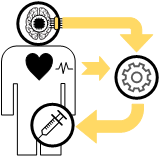
Body Sensors & Actuators
- Biomedical & Neural Sensors (Electrodes/MEMS)
- Compressed and Multi-modal IoB Sensing
- Neural Stimulators, Electronic, Acoustic Actuators
- Energy Harvesting and Innovative Powering
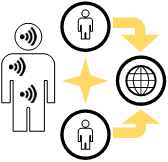
Body Communication
- Wearable and Implantable Body Comm
- Co-Design of Sensing & Communication
- Multi-Sensor On-body Network Architectures
- Multi-Human Networks

Body Electromagnetics
- Electromagnetics-Biomatter Interaction for Sensing, Communication & Actuation
- EM Wave Biosensors Design & Physics
- On-Body Antenna Design & Simulations
- On-Body Acoustics Design & Physics
- SAR & Safety Studies
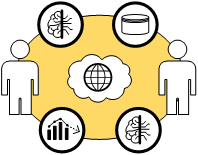
On-Body Intelligence
- In-Sensor, On-Hub Analytics, Edge Intelligence
- Distributed Intelligence (Node/Edge/Cloud)
- Predictive Intelligence (Linear/Model Predictors)
- Latency & Energy Co-Optimization

IoB Security
- Medical Device Security
- Physical/Hardware Security for IoB
- Latency & Energy Sensitive Encryptions
- Privacy-Preserving Processing on IoB Data
- Privacy Policies & Ethical Concerns
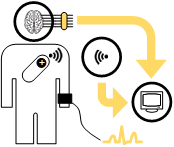
Brain & Body In-Vivo Devices
- Human and Animal In-Vivo Experiments
- Medical-Grade Designs through Collaboration with Doctors
- Brain-Machine Interfaces
- Devices for Neuroscience
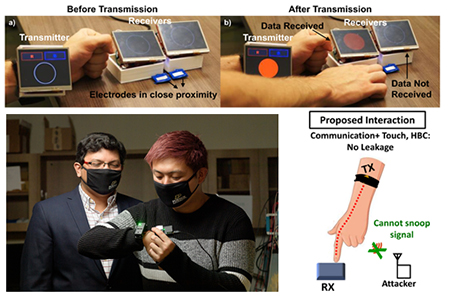
BodyWire-HCI, which utilizes the human body as a wire-like communication channel, enables a novel human–computer interaction, that for the first time, demonstrates selective and physically secure communication strictly during touch.
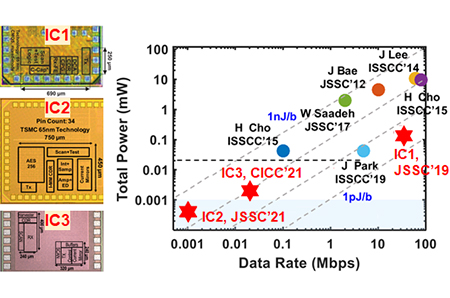
IC1: BodyWire (first sub-10pJ/b HBC Transceiver), IC2: Sub-μWRComm (first Sub-μW HBC Transceiver), and IC3: EQS Res-HBC (first whole-body powering + resonant comm. SoC)
Continuous Advancements in HBC Transceivers (TRX), resulting in the first sub-10pJ/b HBC TRX (BodyWire: IC1), the first Sub-μW HBC TRX (Sub-μWRComm: IC2) and the first whole-body powering + resonant TRX SoC (EQS Res-HBC: IC3).

On the Safety of Human Body Communication
This work analyzes the compliance of the current density and electric/magnetic fields generated in different modalities of HBC with the established safety standards.
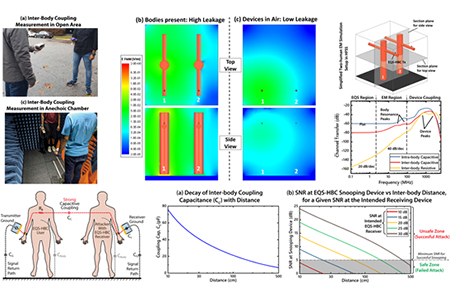
This work studies the function of the human body as a capacitor and its implication in security and interference in EQS-HBC communication. Design strategies are explored to minimize the effect of inter-body coupling.
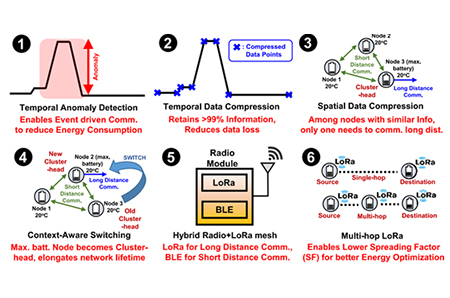
Since communication energy/bit is often over three orders of magnitude compared to computing, pushing intelligence towards the leaf node reduces communication data volume, improving energy/information (500x). Both Spatial and Temporal In-Sensor Analytics is explored.
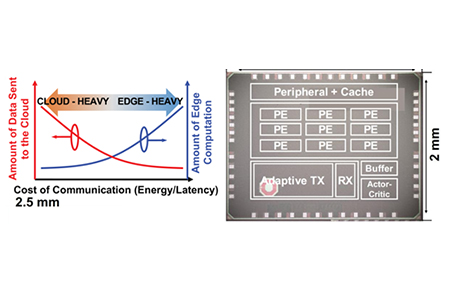
Communication energy depends on the dynamic channel whereas in-sensor computing energy depends on the quality of the sensed data. For the first time a custom SoC with dynamic co-optimization between computation and communication to maintain the IoB node at its minimum energy per information point.
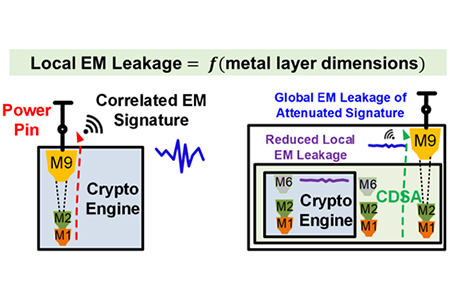
Resource and energy constrained IoB nodes can be attacked using physical (e.g., power and electromagnetic) side channels. This work builds in circuit level physical layer security to improve the resiliency to such attack by over 100x.
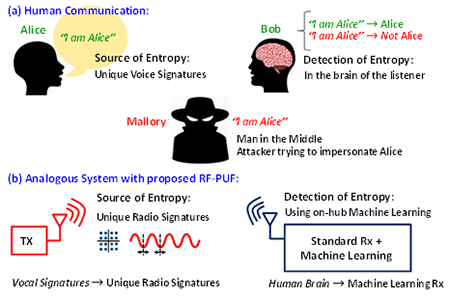
In asymmetric IoB networks, the resource constrained leaf nodes can benefit from enhanced physical security by using the electromagnetic signature automatically imprinted during communication as a fingerprint through machine learning inferences on the hub node. This work builds on the first radio frequency PUF proposed by Purdue.

For the first time a custom SoC is shown with BP-QBC, showing a 0.52μW at 10Mbps, and with >20dB better end-to-end path loss as compared to the state-of-the-art.
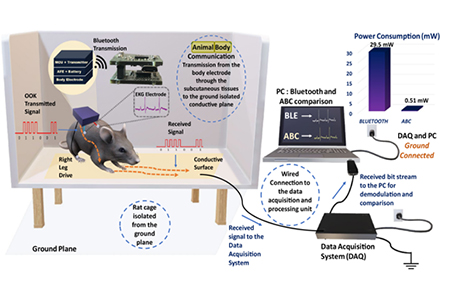
Electro‑Quasistatic Animal Body Communication for Untethered Rodent Biopotential Recording
This work brings the recent advancements of human body communication to animal neuroscience to improve chronic recording times by reducing wireless communication power by an order of magnitude.
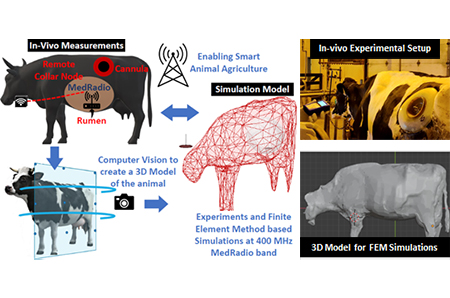
Communication channel model characterization for bovines using novel in-vivo experimental and FEM based simulation techniques at 400 MHz for data transfer from sensors inside rumen outside the body to enable smart animal agriculture.
Featured Projects

BodyWire-HCI, which utilizes the human body as a wire-like communication channel, enables a novel human–computer interaction, that for the first time, demonstrates selective and physically secure communication strictly during touch.

For the first time a custom SoC is shown with BP-QBC, showing a 0.52μW at 10Mbps, and with >20dB better end-to-end path loss as compared to the state-of-the-art.

IC1: BodyWire (first sub-10pJ/b HBC Transceiver), IC2: Sub-μWRComm (first Sub-μW HBC Transceiver), and IC3: EQS Res-HBC (first whole-body powering + resonant comm. SoC)
Continuous Advancements in HBC Transceivers (TRX), resulting in the first sub-10pJ/b HBC TRX (BodyWire: IC1), the first Sub-μW HBC TRX (Sub-μWRComm: IC2) and the first whole-body powering + resonant TRX SoC (EQS Res-HBC: IC3).

Resource and energy constrained IoB nodes can be attacked using physical (e.g., power and electromagnetic) side channels. This work builds in circuit level physical layer security to improve the resiliency to such attack by over 100x.
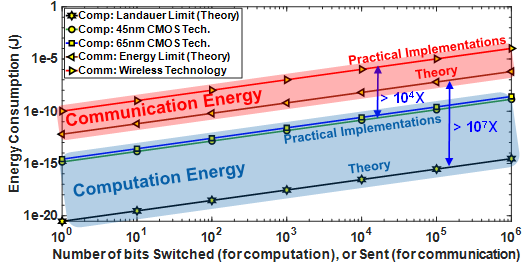
S. Sen, S. Maity and D. Das, "The body is the network: To safeguard sensitive data, turn flesh and tissue into a secure wireless channel," in IEEE Spectrum, vol. 57, no. 12, pp. 44-49, Dec. 2020, doi: 10.1109/MSPEC.2020.9271808.
D. Das, S. Maity, B. Chatterjee, and S. Sen, "Enabling Covert Body Area Network using Electro-Quasistatic Human Body Communication," in Scientific Reports (Nature)- Feb 2019
S. Maity, N. Modak, D. Yang, S. Avlani, M. Nath, J. Danial, D. Das, P. Mehrotra, S. Sen, "Sub-μWRComm: 415-nW 1–10-kb/s Physically and Mathematically Secure Electro-Quasi-Static HBC Node for Authentication and Medical Applications," in IEEE Journal of Solid-State Circuits, 2021
D. Das , J. Danial, A. Golder, N. Modak, S. Maity, B. Chatterjee, D. Seo, M. Chang, A. Varna, H. Krishnamurthy, S. Mathew, S. Ghosh, A. Raychowdhury, S. Sen, "EM and Power SCA-resilient AES-256 in 65nm CMOS through >350x Current Domain Signature Attenuation," in IEEE International Solid- State Circuits Conference (ISSCC 2020)
S. Sriram, S. Avlani, M. P. Ward, and S. Sen, "Electro-Quasistatic Animal Body Communication for Chronic Untethered Rodent Biopotential Recording". in Scientific Reports(Nature), 2021